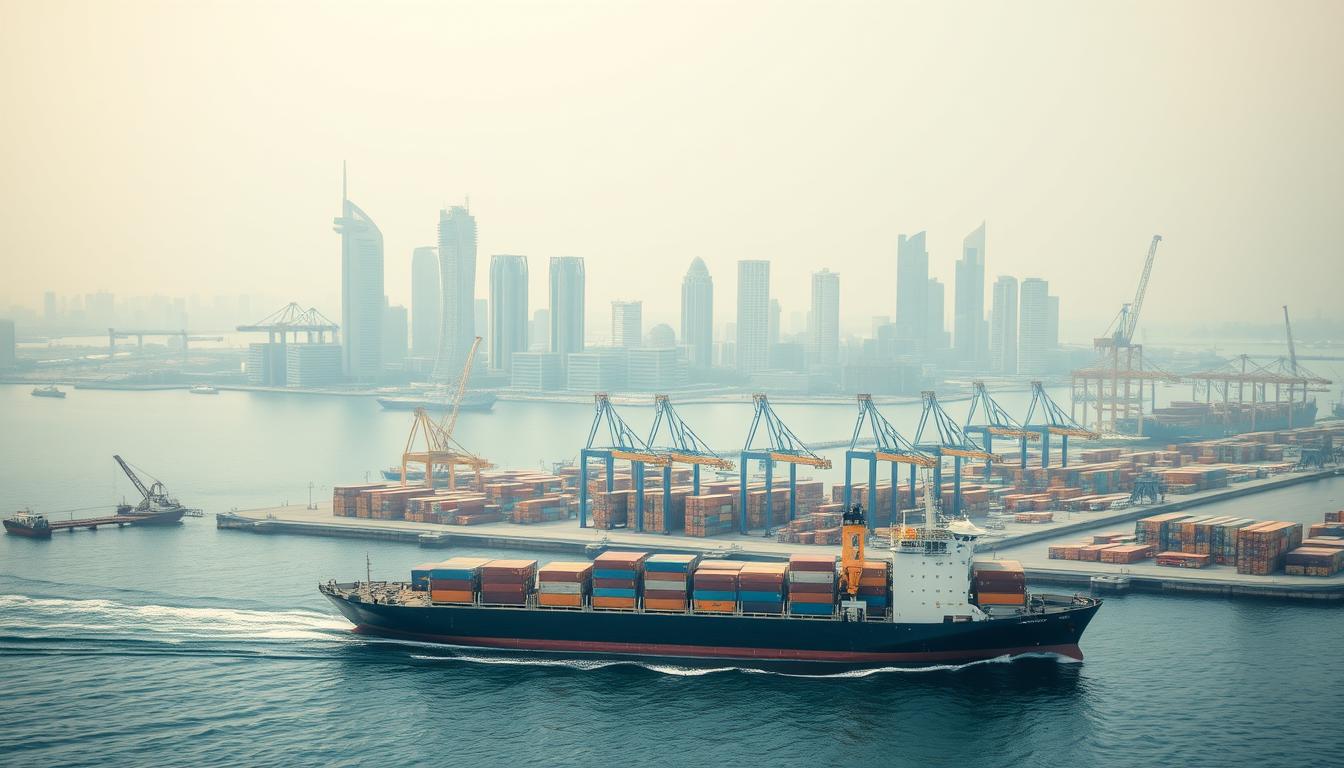Now Reading: Streamline Logistics with Blockchain Tracking Technology
- 01
Streamline Logistics with Blockchain Tracking Technology
Streamline Logistics with Blockchain Tracking Technology
The COVID-19 pandemic revealed glaring weaknesses in how goods move globally. Consumers now demand more than fast shipping – they want clarity about product origins and ethical practices. Businesses face mounting pressure to predict disruptions, prove sustainability efforts, and foster collaboration across partners.

Modern solutions tackle these challenges through decentralized record-keeping systems. These tools create unchangeable transaction histories visible to all authorized parties. Unlike outdated methods prone to errors, this approach ensures real-time accuracy from raw materials to final delivery.
Companies using these systems gain strategic advantages. For instance, sustainable agriculture practices benefit from verifiable environmental data shared across networks. This builds consumer confidence while streamlining compliance reporting.
Key Takeaways
- Global disruptions accelerated demand for end-to-end operational visibility
- Secure digital ledgers prevent data manipulation across partner networks
- Real-time monitoring helps anticipate bottlenecks before delays occur
- Consumers increasingly reward brands with transparent sourcing practices
- Automated record-keeping reduces administrative costs by up to 30%
Understanding the Evolving Landscape of Supply Chain Management
Shifting consumer demands and unexpected crises are rewriting supply chain rules. Where speed once dominated priorities, businesses now prioritize operational flexibility and ethical sourcing. This change stems from recent events that exposed vulnerabilities in traditional models.
The Impact of Global Disruptions on Supply Chains
The pandemic shattered assumptions about “just-in-time” delivery systems. Store shelves emptied as shipping delays affected everything from electronics to groceries. But health crises aren’t the only threat—geopolitical conflicts, cyberattacks, and extreme weather now regularly disrupt material flows.

Emerging Trends in Supply Chain Resilience
Forward-thinking companies now build systems that adapt to sudden changes. Many maintain backup suppliers or regional warehouses to prevent bottlenecks. Digital tools play a crucial role, offering real-time data to predict issues before they escalate.
Environmental and social factors also shape modern strategies. Firms track carbon footprints across their networks while ensuring fair labor practices. This dual focus on stability and ethics meets both consumer expectations and regulatory demands.
Blockchain Technology: The New Backbone of Supply Chains
Modern business networks require systems that balance transparency with operational efficiency. Traditional record-keeping methods struggle to keep pace with multi-party collaborations, often leading to disputes and delays. A revolutionary approach now enables organizations to share critical information securely while maintaining full audit trails.

Fundamental Principles of Blockchain
At its core, this system groups verified actions into timestamped blocks. Each block connects to the previous one using advanced cryptography, forming an unbreakable chain. This structure ensures historical records remain intact – any alteration would disrupt the entire sequence.
Distributed networks store copies of the ledger across multiple locations. No single entity controls the data, preventing unilateral changes. In transparent supply chains, this setup allows suppliers, manufacturers, and retailers to access identical information simultaneously.
Benefits of a Decentralized Ledger in Supply Chains
Shared record systems eliminate costly intermediaries while reducing errors. Automated smart contracts trigger payments or shipments when predefined conditions meet, cutting processing times. Participants gain real-time visibility into material movements without compromising sensitive details.
The technology’s tamper-proof nature builds trust among partners. Companies can verify ethical sourcing claims or compliance certifications directly through the network. This capability proves vital for industries facing strict regulatory oversight or consumer demands for accountability.
How Blockchain Logistics Tracking Transforms the Supply Chain
The digital age demands accountability, pushing industries to adopt transformative methods for monitoring product journeys. Decentralized systems now enable businesses to document every movement with precision, replacing outdated manual logs prone to human error. This shift addresses growing demands for ethical sourcing and operational agility.

Real-Time Tracking and Enhanced Transparency
Modern digital ledgers provide live updates across production networks. Authorized partners access identical data simultaneously, eliminating version conflicts common in traditional setups. When a shipment temperature exceeds thresholds or customs paperwork lags, alerts trigger instant corrective actions.
Three critical advantages emerge:
- Instant issue detection: Sensors and smart devices feed data directly into shared platforms, revealing bottlenecks during transit
- Verifiable provenance: Customers scan QR codes to view harvest dates, factory conditions, or transportation routes
- Collaborative workflows: Suppliers and retailers coordinate deliveries using unified timelines, reducing warehouse delays
Pharmaceutical companies now trace vaccine storage conditions across continents, while coffee brands prove fair trade practices from farm to shelf. This approach turns compliance from a cost center into a trust-building asset.
Benefits of Integrating Blockchain in Supply Chain Operations
Businesses gain measurable advantages when adopting modern solutions for managing interconnected networks. These systems act as digital guardians, preserving historical accuracy while enabling instant access to critical operational details. Unlike fragmented databases, they create a single source of truth accessible to authorized partners worldwide.
Enhanced Traceability and Data Integrity
Every product journey becomes fully documented through timestamped digital records. Suppliers document material origins, factories confirm production dates, and shippers validate delivery routes – all stored in cryptographically secured blocks. This approach eliminates disputes about shipment conditions or compliance status.
Companies maintain control over sensitive information while sharing verified updates. For example, a food manufacturer could prove organic certification without revealing supplier contracts. Retailers access real-time inventory data to adjust orders before shortages occur.
Three operational improvements stand out:
- Automated alerts for temperature changes or customs delays
- Instant verification of sustainability claims through shared ledgers
- Reduced payment delays via self-executing smart contracts
These upgrades work alongside existing management software, avoiding costly system replacements. Teams spend less time reconciling spreadsheets and more time addressing strategic challenges. The result? Faster decision-making, stronger partner relationships, and 30% fewer administrative errors in cross-border transactions.
Security and Data Integrity: Safeguarding the Supply Chain
In an era of cyber threats, securing supply chain data is non-negotiable. Advanced cryptographic methods now protect sensitive transaction records across global networks. These systems create digital fingerprints for every action, making unauthorized changes instantly detectable.
Modern security architecture uses one-way hashing to lock down information. Each piece of data gets a unique code that changes completely if altered. Distributed networks store identical copies across multiple locations – tampering with one copy triggers automatic rejection by the entire system.
Industry leaders like OpenZeppelin and CertiK have developed standardized frameworks to reduce risks. Their tools help businesses implement secure smart contracts while meeting data privacy and integrity requirements. These solutions align with ERC guidelines, ensuring compatibility across platforms.
Three critical safeguards emerge:
- Consensus mechanisms requiring multiple approvals for new entries
- Real-time alerts for suspicious activity patterns
- Automatic verification of partner credentials and certifications
These layered approaches maintain operational continuity even during breaches. Companies gain bulletproof audit trails while sharing only necessary details with partners. The result? Stronger trust, fewer disputes, and protection against costly fraud attempts.
Integrating Blockchain with IoT, AI, and Smart Contracts
Modern supply chains thrive when multiple innovations work together. Combining real-time data streams with automated decision-making creates self-correcting networks. These systems turn raw information into actionable insights while maintaining ironclad security.
Leveraging IoT for Real-Time Data Collection
Connected sensors act as digital eyes across transportation routes and storage facilities. Devices monitor temperature fluctuations in pharmaceuticals and track produce freshness during transit. This constant data flow feeds into secure networks, creating permanent records of product conditions.
Shipping containers now transmit location updates every 15 minutes. Warehouse humidity levels get logged automatically. These details help companies prove compliance with safety standards while identifying inefficiencies.
The Role of Smart Contracts in Automating Processes
Self-executing agreements revolutionize routine tasks. When goods reach specified checkpoints, preprogrammed rules trigger payments or inventory updates. A seafood shipment arriving at -18°C might automatically release funds to suppliers.
Three benefits emerge:
- Faster transactions: Payments clear in hours instead of weeks
- Error reduction: Machines handle repetitive tasks flawlessly
- Trust building: Partners share verified data without third parties
Artificial intelligence adds another layer by predicting delivery delays using historical patterns. These systems learn from every shipment, constantly refining their forecasts. Together, these tools create supply chains that adapt faster than market changes.
Strategies for Implementing Blockchain in Supply Chains
Adopting new systems requires careful planning and collaboration across all business units. Supply chain leaders should host workshops with manufacturers, distributors, and retailers to map shared challenges. These discussions clarify where decentralized ledgers add real value versus traditional methods.
Start by identifying pain points like delayed payments or unclear sourcing. Pilot programs with trusted partners allow teams to test solutions without full-scale investment. Walmart’s food traceability initiative, for example, began with mango suppliers before expanding systemwide.
Cost-benefit analyses must weigh technical needs against operational gains. While setup costs vary, many companies see ROI through reduced disputes and faster audits. Prioritize features that solve immediate problems, such as automated compliance checks or real-time inventory updates.
Training programs ensure smooth transitions. Cross-departmental teams learn to use shared platforms while maintaining data security protocols. This phased approach builds confidence in the technology’s ability to streamline multi-party workflows.
Successful implementation hinges on aligning stakeholders around measurable goals. Regular progress reviews keep projects on track while adapting to new supply chain realities. The result? Networks that move goods faster, cheaper, and with unmatched transparency.
FAQ
How does decentralized ledger technology improve transparency in supply chains?
Distributed ledgers provide real-time visibility into product journeys by recording every transaction across multiple parties. This reduces discrepancies and builds trust through immutable records accessible to authorized participants.
What are the advantages of combining IoT devices with distributed ledgers?
IoT sensors, like those used by Maersk and IBM’s TradeLens, collect temperature or location data. When paired with decentralized systems, this ensures accurate, tamper-proof monitoring of goods from origin to delivery.
Can smart contracts reduce delays in international shipments?
Yes. For example, Walmart uses automated agreements to trigger payments upon verifying delivery conditions. This eliminates manual checks and speeds up processes like customs clearance or invoice approvals.
How does cryptographic security protect against counterfeit products?
Each product’s history—from raw materials to retail—is stored on an unalterable ledger. Companies like De Beers use this to verify diamond origins, making it nearly impossible for fake items to enter the system undetected.
What challenges do companies face when adopting decentralized systems?
Initial costs, interoperability with legacy tools, and training teams are common hurdles. Partnerships with platforms like VeChain or Ethereum Enterprise help streamline integration without overhauling existing infrastructure.
How do decentralized systems handle data privacy across global networks?
Permissioned ledgers restrict access to verified participants. FedEx’s blockchain-based system, for instance, encrypts sensitive details while sharing only necessary shipment updates with relevant stakeholders.
Why is traceability critical for industries like pharmaceuticals?
Tracking drug batches in real time ensures compliance with safety regulations. Pfizer’s pilot programs show how immutable records help quickly identify contaminated batches, reducing recalls and protecting public health.













